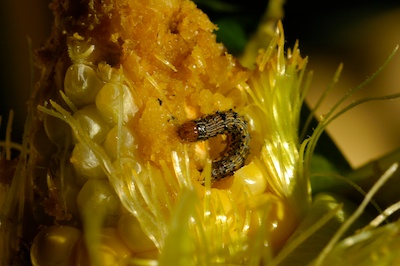
The variety and abundance of food in California hits its peak in the summer. But at what cost? When shopping at farmer's markets, one is practically delighted to see worms and grubs on the fruit and vegetables - after all isn't the presence of bugs an indication that food is organic? Yet what if food that receives heavy application of pesticides still bears pests, as in the case with this ear of corn? (left hand image) The reality is that insects can develop resistance to pesticides. The war on pests is actually a treadmill; over time it will take more and more effort to go nowhere.
On the flip-side, even if one was adamant about the use of pesticides in order to maintain crop yields, the fact remains that food production requires pollinating insects and the nutrient cycling services provided by detritus feeders. Most pesticides, however, are broad spectrum, and kill all insects regardless of whether or not they are beneficial. In fact, the U.S. Fish and Wildlife Service reports that one-fifth of beneficial honeybees colonies, along with 67 million birds, are killed each year due to pesticide exposure. This results in a scenario which requires even more time and energy to correct.
The answer seems not to be in attempting to eradicate pests, which develop resistance to the chemicals we throw at them, but rather in modeling healthy ecosystems using a method known as Integrated Pest Management. With IPM, both beneficial and detrimental insects exist in the field, but a balance is achieved that still provides abundant harvests. We also avoid forcing future generations to develop increasingly toxic pesticides and from bearing the responsibility for rehabilitating degraded ecosystems.